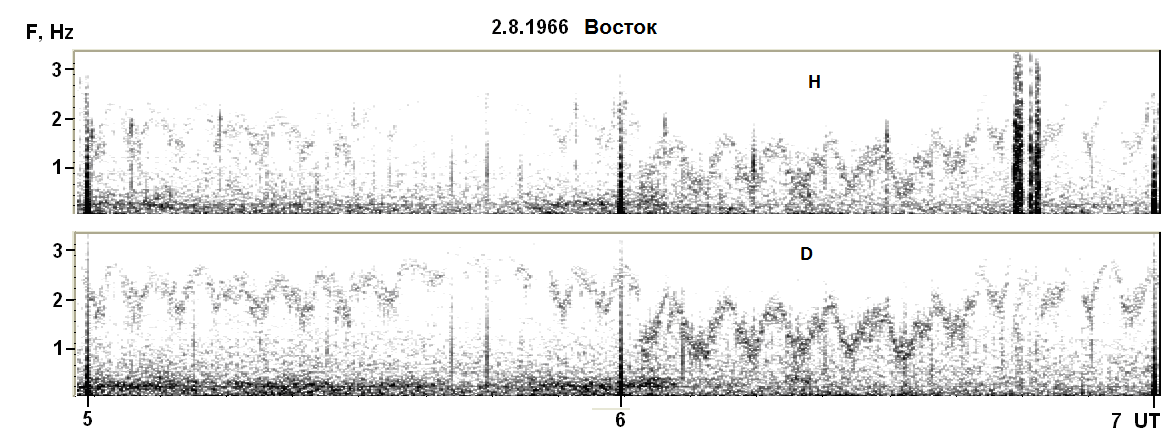Borok, Russian Federation
Borok, Russian Federation
Moscow, Russian Federation
UDK 55 Геология. Геологические и геофизические науки
We study frequency modulation of serpentine emission (SE), using data from the Vostok Antarctic station. It is shown that the previously observed 5-minute modulation of the SE carrier frequency is the most prominent and stable in the emission spectrum. Frequency fluctuations of this period are present in about 70 % of the total SE observation time under moderately quiet geomagnetic conditions (Kp=0–2). We performed a per-pixel processing of SE dynamic spectra and found that the power spectrum of the signal frequency modulation contains a clearly visi-ble peak at periods close to 5 minutes. A detailed study shows the emission spectrum matching the frequency range of the solar photospheric oscillations. The results of the analysis allow us to conclude that the 5-minute modulation of the SE carrier frequency can be viewed as a reflection of photospheric fluctuations with the same period that is typical for the solar eigenoscillations.
serpentine emission, frequency modulation, power spectrum, photospheric oscillations
ВВЕДЕНИЕ
Серпентинная эмиссия — квазинепрерывные геомагнитные пульсации, которые часами, а иногда и сутками наблюдаются в области полярной шапки в спокойной и умеренной геомагнитной обстановке. Основное свойство этого излучения определяется глубокой модуляцией несущей частоты, изменяющейся на 1–2 октавы в диапазоне частот от 0.01 до 5 Гц. Излучение было обнаружено в 70-е годы прошлого столетия в Антарктиде на ст. Восток [Гульельми, Довбня, 1973, 1974; Guglielmi, Dovbnya, 1974]. Характерные свойства SE позволили предположить, что частотно-модулированные колебания проникают в полярные шапки из межпланетной среды, где они возбуждаются в виде ионно-циклотронных волн в результате неустойчивости плазмы с анизотропным распределением ионов по скоростям [Гульельми, Довбня, 1973, 1974; Guglielmi, Dovbnya, 1974]. В дальнейшем эмиссия была также зарегистрирована на станции «Дэвис» [Morris, Cole, 1987] и в Северном полушарии на арктической станции «Ню-О́лесунн», Шпицберген [Asheim, 1983]. Cвойства SE обсуждались и уточнялись в работах [Гульельми, Довбня, 1973, 1974; Guglielmi, Dovbnya, 1974; Гульельми, 1979; Troitskaya, 1979; Fraser-Smith, 1982; Asheim, 1983; Morris, Cole, 1986, 1987; Guglielmi, Pokhotelov, 1996]. Одна из недавно обнаруженных особенностей серпентинной эмиссии состоит в том, что в спектре SE присутствует устойчивая, длящаяся несколько часов 5-минутная модуляция несущей частоты [Guglielmi et al., 2015]. Подобный пример показан на рис. 1.

Рис. 1. Пример динамического спектра H- и D-компонент SE с 5-минутной модуляцией несущей частоты
Факт совпадения периода обнаруженной в спектре SE частотной модуляции с 5-минутным периодом, характерным для колебаний фотосферы Солнца, представляет несомненный интерес, так как, по всей видимости, свидетельствует о существовании генетической связи частотной модуляции эмиссии с пульсациями солнечной поверхности.
В настоящей работе более детально исследуются спектральные особенности SE по наблюдениям на обсерватории Восток за 1966–1971 гг.
1. Asheim S. Serpentine emissions in the polar magnetic field. Oslo, 1983, 8 р. (Rep. Ser. No. 83-38, Inst. of Physics).
2. Christensen-Dalsgaard J. Helioseismology. Rev. Mod. Phys. 2002, vol. 74, pp. 1073-1129. DOI:https://doi.org/10.1103/RevModPhys. 74.1073.
3. Dovbnya B.V., Zotov O.D., Klain B.I., Kurazhovskaya N.A. Dynamics of the SE-type emission before intense proton flares on the Sun. Geomagnetism and Aeronomy. 1994, vol. 34, no. 3, pp. 419-421.
4. Elsworth Y., Howe R., Isaak G.R., McLeod C.P., Miller B.A., van der Raay H.B., Wheeler S.J., New R. Performance of the BISON network 1981-present. Helio- and Astero-Seismology from Earth and Space (GONG’94): Proc. San Francisco, 1995. рр. 392-397. (ASP Conference Ser. No. 76 / Eds. R.K. Ulrich, E.J. Rhodes, Jr., and W. Dappen).
5. Fraser-Smith A.C. ULF/lower-ELF electromagnetic field measurements in the polar caps. Rev. Geophys. Space Phys. 1982, vol. 20, pp. 497-512. DOI:https://doi.org/10.1029/RG020i003p00497.
6. Guglielmi A.V. MGD-volny v okolozemnoi plazme [MHD Waves in the Near-Earth Plasma]. Moscow, Nauka Publ., 1979, 139 p. (In Russian).
7. Guglielmi A.V., Dovbnya B.V. Hydromagnetic emission of the interplanetary plasma. Pis’ma v ZhETF [JETP Letters]. 1973, vol. 18, iss. 10, pp. 601-604. (In Russian).
8. Guglielmi A.V., Dovbnya B.V. Hydromagnetic emission of the interplanetary plasma. Astrophys. Space Sci. 1974, vol. 31, pp. 11-29.
9. Guglielmi A.V., Dovbnya B.V. Observations of geomagnetic pulsations in the range of 0-2 Hz with deep modulation of the carrying frequency. Geomagnetizm i aeronomiya [Geomagnetism and Aeronomy]. 1974, vol. 14, no. 5, pp. 868-870. (In Russian).
10. Guglielmi A.V., Pokhotelov O.A. Geoelectromagnetic Waves. Bristol, Philadelphia, IOP Publ. Ltd., 1996. 402 p.
11. Guglielmi A., Potapov A., Dovbnya B. Five-minute solar oscillations and ion-cyclotron waves in the solar wind. Solar Phys. 2015, vol. 290, no. 10, pp. 3023-3032. DOI: 10.1007/ s11207-015-0772-2.
12. Morris R.J., Cole K.D. “Serpentine emission” at the high latitude station Davis (17-23 September 1981). Exploration Geophys. 1986, vol. 17, p. 15. DOI:https://doi.org/10.1071/EG986015.
13. Morris R.J., Cole K.D. “Serpentine emission” at the high latitude Antarctic station, Davis. Planet. Space Sci. 1987, vol. 35, pp. 313-328. DOI:https://doi.org/10.1016/0032-0633(87)90158-9.
14. Potapov A.S., Polyushkina T.N., Pulyaev V.A. Observations of ULF waves in the solar corona and in the solar wind at the Earth's orbit. J. Atmos. Solar-Terrestrial Phys. 2013, vol. 102, pp. 235-242. DOI:https://doi.org/10.1016/j.jastp.2013.06.001.
15. Troitskaya V.A. Geomagnetic pulsations in the polar cap. International Workshop on Selected Topics of Magnetospheric Physics. Magnetospheric Study: Proc. Tokyo, Japanese IMS Comm., 1979, pp. 121-123.



















